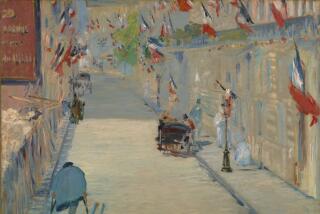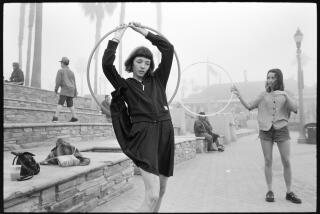Restoring a Photographer’s Fading Image : LOOKING FOR THE LIGHT: The Hidden Life and Art of Marion Post Wolcott, <i> By Paul Hendrickson (Alfred A. Knopf: $35; 297 pp., with 92 black-and-white photographs)</i>
- Share via
This is one of the stranger biographies you’re likely to read. By turns a mash note, an apology, a respectful homage, a feminist tract and a sentimental evocation of 1930s America, Hendrickson’s book on Farm Security Administration photographer Marion Post Wolcott is as much an excursion into the deep recesses of his own psyche and an inquiry into the complex relationship between a biographer and his subject as it is the story of an artist’s life.
In this, the book is both gratifying and irritating. Art writing tends to be rather dry and academic, so it’s refreshing to find someone bringing some poetry and imagination to the subject. At the same time, Hendrickson’s overly familiar tone tends to be cloying, cute and entirely too pleased with itself. He refers to photographers as “shooters” or “squinters,” for instance, while photographs are “rectangles.” Plain English will do just fine, Mr. Hendrickson.
Having acclimated oneself to Hendrickson’s breezy style, one is apt to be struck by how thoroughly “Looking for the Light” was researched, and then by the fact that Wolcott led a fairly uneventful life. She had a middle-class upbringing, was an artist for a few years, then got married. There were few premarital love affairs, no important friendships and she didn’t seem to have a particularly searing intellectual life. What she mostly had was a great deal of spunk and a good eye.
The facts Hendrickson succeeded in digging up about Wolcott’s life are colored by the tremendous passion he feels for her, and at various points one realizes with frustration that we’re learning more about the author than we are about the subject of this book. Hendrickson clearly began “Looking for the Light” because he had a crush on Wolcott as he imagined her in the 1930s, and it’s fascinating to observe how his love for her deepens and changes as he pieces together the story of her life and finally comes to know her personally as an old woman in the final years of her life. It’s in the last 50 pages that the book redeems itself, as we observe Hendrickson relinquishing his illusions about Wolcott and pondering the responsibility of the artist to his or her talent.
The question that ostensibly drives this book is why Marion Post Wolcott, a promising young artist who created an extraordinary body of work in just three years, suddenly abandoned photography and never looked back. The answer to that question is apparent in the simple facts of her life. Born in 1910 in Bloomfield, N.J., Marion was one of two daughters born to Nan Post, a woman who was a frustrated artist and a feminist long before that was acceptable. The parents divorced after Marion’s mother conducted a scandalous affair with a boarder, and this split launched Nan Post on a rootless and lonely existence. The trauma of her mother’s life no doubt played a key role in the decision Marion Wolcott was later to make when faced with a choice between a stable home life and a career as an artist.
The book gets off to a shaky start as Hendrickson recounts how his discovery of Wolcott’s work roused him from the depths of depression and broke him out of a crippling writer’s block. The interesting point that surfaces from this self-indulgent passage is that the redemptive powers of a creative obsession, like falling in love, can rescue a person from despair. This is exactly what happens with Hendrickson, whose infatuation with Wolcott was all-consuming; in fact, he dwells a bit more than is necessary on her physical beauty and abundance of suitors she had, and one quickly realizes that Hendrickson himself is a suitor of sorts.
Hendrickson’s courtship of Wolcott drove him to travel the routes she took through the South, visit the sites of several of her photographs and grill the locals about what life was like there when Wolcott passed through in the 1930s. He managed to track down a few of the people she photographed, and there are lengthy accounts of those encounters, as well as a long explanation of the Speed Graphic Camera she used and several detailed and highly fanciful dissections of specific photographs. (A one-page “chapter” consists of an itemized list of everything on the shelf in a kitchen in one of the photographs.)
In this middle section the book threatens to derail into minutiae, and one begins to wonder exactly what Hendrickson is looking for. At this point the book seems like a sad attempt by the author somehow to consummate the love he felt for a woman who has disappeared into old age.
Hendrickson charts Wolcott’s movements during the years she was on assignment for the FSA through the correspondence she maintained with many people, most notably with Rod Stryker, the man who ran the FSA, a government project attempting to photographically document the effects of the Depression. Hendrickson quotes liberally from Wolcott’s letters, which are a pleasure to read. She was a very witty woman, fiercely independent, intelligent and highly sensitive to the world she was photographing.
Wolcott’s keen sensitivity was central to her photographic style. Like Walker Evans, who created a stylistically similar visual record of America in the ‘30s, Wolcott’s work is straightforward, impeccably framed and intensely romantic despite the hardships it often depicts; as did Evans, Wolcott had a talent for investing simplicity and poverty with tremendous dignity. She had a good eye for detail as well, and her pictures have great depth--the backgrounds are invariably as rich and complex as the foregrounds. The most striking thing about her work, however, is the profound nostalgia it evokes for an idealized America of the past. In the tradition of painters such as Winslow Homer, Thomas Hart-Benton and Edward Hopper, Wolcott’s pictures read as visual distillations of all we once found so admirable about the American character.
Surprisingly, it’s only when Hendrickson gets past his somewhat maudlin imaginings of Wolcott at the height of her creative powers during the Depression and into her relationship with the man who was to change her life, Lee Wolcott, that his story picks up steam. When Lee Wolcott first arrives on the scene, it looks as though Hendrickson is going to paint him as the heavy in this story--the husband who quashed his wife’s artistic life--and many things are said about Lee Wolcott, both by Hendrickson and by people who knew him, that aren’t terribly flattering.
However, when Hendrickson comes to know Marion and Lee Wolcott in the three years prior to the artist’s death in Santa Barbara in 1990, he writes of Lee and of the love affair that brought an end to Wolcott’s career with great tenderness and respect. As a result of lengthy conversations with both Wolcotts, Hendrickson concludes that raising four children, as Marion did, and maintaining a long and devoted marriage are creative acts equal to the greatest artwork. He suggests that Wolcott felt twinges of regret about what might have been, but makes it clear she never doubted she’d made the right decision in laying aside her camera for the man she loved. Whether or not one agrees with Wolcott should reveal much to the reader concerning his own beliefs about the value of art, romantic love and family.
More to Read
Sign up for our Book Club newsletter
Get the latest news, events and more from the Los Angeles Times Book Club, and help us get L.A. reading and talking.
You may occasionally receive promotional content from the Los Angeles Times.






